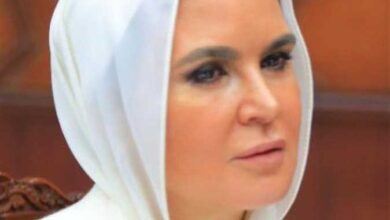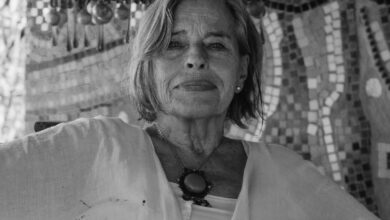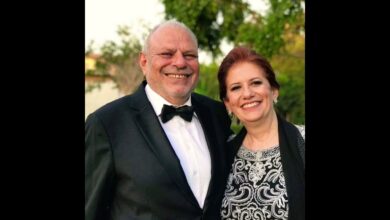“An artist is never indifferent to injustice. When confronted by the sufferings of others, an artist uses art to restore order.”
With these words, Ann Shafer opened the panel discussion on Social Justice in the Contemporary Visual Arts on Wednesday, part of this year’s American University in Cairo (AUC) Annual Research Conference, dedicated to Social Justice: Theory, Research and Practice. The panel hosted visual artist Khaled Hafez, professor and artist Nagla Samir, curator Aida Eltorie and visual artist Shady El Noshokaty.
Right up until the day before, the panel’s organizers were considering cancelling the event in protest against the administration of Visual Arts Department at AUC. As Shafer – moderator of the panel – explained after the conference, this year both art faculty and students have been harassed by the administration.
“The department has struggled for a long time, due to lack of funding and of interest in general. The change of administration this year seemed to be an opportunity,” Shafer said. Instead, all the plans proposed will be implemented without a real consultation of either faculty or students. The administration responded aggressively to faculty’s initiatives and Shafer herself was removed from the position of Art Program Director. “They stood on our way every time. The art gallery [run by the department] had just two shows out this year”.
But holding the discussion could be a more effective way to speak out than canceling it, especially considering its theme. Social justice in art is a relevant topic in an environment that curtails participation. Moreover, after the revolution it had become a “chance to talk about what change art might document, reflect and produce,” Shafer said during the introduction.
Several Egyptian artists engage with social justice individually, “but we have never considered their communalities”, says Shafer, and the issue is quite overlooked in art discourse. The panel, modified after the 25 January revolution to be more relevant, aimed to start filling this gap by suggesting social justice as a viable theme. The talks focused on the way art, by well-known Egyptian artists and at a more popular level by cartoons and caricatures, has engaged social justice and social critique in general for long time.
Hafez showed works by Nermine Hammam, Sabah Naim, Marwa Adel, Huda Lutfy and Hazem Taha Hussein as reflections on topics such as gender discrimination, physical violence, migration and the search for personal identity. In his presentation, Hafez defined art as an act of social expression, stressing that the unavoidable task of contemporary art is to talk about our time and its issues.
Eltorie and Noshokaty paid tribute to the visual change that happened on the streets during the revolution and the involvement of Egyptian artists in the uprising. Eltorie, curator of the Egyptian pavilion at this year’s Venice Biennale, reiterated that the pavilion will show "Thirty Days of Running in Place”, the last work made by artist Ahmed Basiony before he was killed when participating in the revolution. Noshokaty screened a documentary dedicated to Basiony.
Social critique, very much present in the Egyptian scene since before 25 January, will be all the more present now. There is a new potential for pointed critiques of society since much political censorship has been removed, though Nagla Samir warns that “informal censorship and taboos are still effective”.
Samir’s talk focused on the flourishing of more popular kinds of art and their communicative role. For long time now, caricatures and cartoons, often mistakenly considered as lower quality art, have been tackling the right to participate, freedom of expression, political repression, social and economical inequality, and harassment of all kinds. Production that has enormously increased in the past few months. During the 18 days of pro-democracy protests, people in Tahrir Square entertained themselves with all sorts of jokes. As Samir explains, a caricature or a cartoon can be particularly effective in delivering a critical message by passing it through a laugh. And, in this moment in Egyptian history, a communicative kind of art is needed, one that is easily accessible. For this reason, popular culture as expressed on the street and circulated in the independent media is taking a central position. It does not just reach a larger audience, but it also engages people on a different level, opening new space for creativity. “During the protest, protesters themselves were the artists”, as Samir says.
Along with circulation and popular engagement, a broader question on accessibility in a society as stratified as the Egypt's soon comes into play. “There is a massive problem with education. Art and music used to be compulsory in school (…) but in the last 30 years they have been taken out of the curricula."
Hafez detects the main problem in schooling. “[Existing] art programs are not capable of beating the problem,” he said, explaining that their task is particularly hard as they receive no support from the government or the media to campaign for art education.
Even though the conference did not openly tackle this issue, social justice in art is also a matter of accessibility to a discourse on art that has been quite elitist for long time. “In Egypt a western discourse on art, imposed from without, has been surrounded by an aura. (…) Thanks to the nature itself of the revolution a more natural discourse can come up,” Shafer says. The same grassroots movement of people that collective expressed the need for democracy may now develop a fresher discourse on art and culture, one that can reach a broader audience and grow naturally out of that part of Egyptian society left aside for so long. “It will be challenging for cultural agents. It will take sensitivity, passion and commitment (…) but this is the direction society is taking.”
Such a discourse does not talk in terms of native art but of more participatory and accessible art. As Shafer concluded: “It is a process that might be already ongoing and we simply haven’t recognized it yet.”




